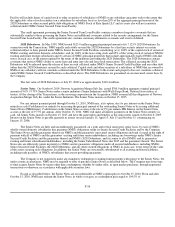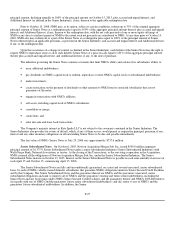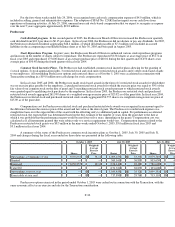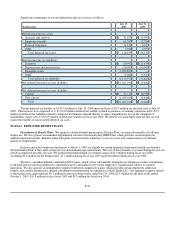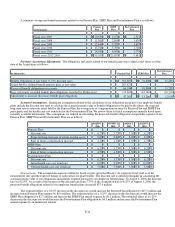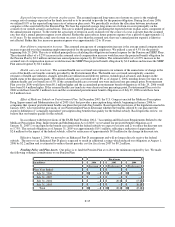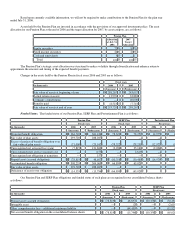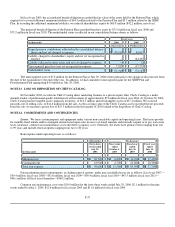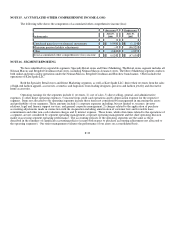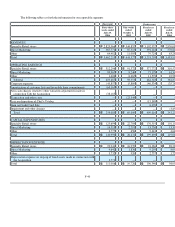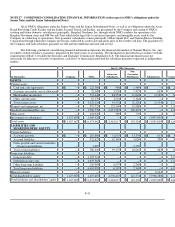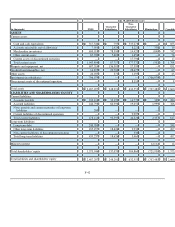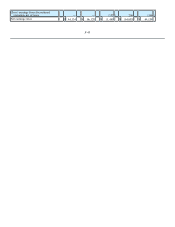Neiman Marcus 2005 Annual Report Download - page 115
Download and view the complete annual report
Please find page 115 of the 2005 Neiman Marcus annual report below. You can navigate through the pages in the report by either clicking on the pages listed below, or by using the keyword search tool below to find specific information within the annual report.
Expected long-term rate of return on plan assets. The assumed expected long-term rate of return on assets is the weighted
average rate of earnings expected on the funds invested or to be invested to provide for the pension obligation. During fiscal year 2006,
we utilized 8.0% as the expected long-term rate of return on plan assets. We periodically evaluate the allocation between investment
categories of the assets held by the Pension Plan. We base the expected average long-term rate of return on assets principally on the
counsel of our outside actuaries and advisors. This rate is utilized primarily in calculating the expected return on plan assets component of
the annual pension expense. To the extent the actual rate of return on assets realized over the course of a year is greater than the assumed
rate, that year's annual pension expense is not affected. Rather this gain reduces future pension expense over a period of approximately 12
to 18 years. To the extent the actual rate of return on assets is less than the assumed rate, that year's annual pension expense is likewise
not affected. Rather this loss increases pension expense over approximately 12 to 18 years.
Rate of future compensation increase. The assumed average rate of compensation increase is the average annual compensation
increase expected over the remaining employment periods for the participating employees. We utilized a rate of 4.5% for the periods
beginning July 29, 2006. This rate is utilized principally in calculating the obligation and annual expense for the Pension and SERP Plans.
The estimated effect of a 0.25% increase in the assumed rate of compensation increase would increase the projected benefit obligation for
the Pension Plan by $2.3 million and increase annual pension expense by $0.3 million. The estimated effect of a 0.25% increase in the
assumed rate of compensation increase would increase the SERP Plan projected benefit obligation by $1.0 million and increase the SERP
Plan annual expense by $0.1 million.
Health care cost trend rate. The assumed health care cost trend rate represents our estimate of the annual rates of change in the
costs of the health care benefits currently provided by the Postretirement Plan. The health care cost trend rate implicitly considers
estimates of health care inflation, changes in health care utilization and delivery patterns, technological advances and changes in the
health status of the plan participants. We utilized a health care cost trend rate of 8% as of August 1, 2006, trending down over time to an
ultimate health care cost trend rate of 5%. If the assumed health care cost trend rate were increased one percentage point, Postretirement
Plan costs for 2006 would have been $0.1 million higher and the accumulated postretirement benefit obligation as of July 29, 2006 would
have been $1.4 million higher. If the assumed health care trend rate were decreased one percentage point, Postretirement Plan costs for
2006 would have been $0.1 million lower and the accumulated postretirement benefit obligation as of July 29, 2006 would have been
$1.2 million lower.
Effect of Medicare Subsidy on Postretirement Plan. In December 2003, the U.S. Congress enacted the Medicare Prescription
Drug, Improvement and Modernization Act of 2003 (Act) that provides a prescription drug subsidy, beginning in January 2006, to
companies that sponsor postretirement health care plans that provide drug benefits. Based upon the provisions of the legislation enacted in
January 2005, we reviewed the provisions of our Postretirement Plan to determine whether the benefits offered by our plan meet the
statutory definition of "actuarially equivalent" prescription drug benefits that qualify for the federal subsidy. Based upon this review, we
believe that our benefits qualify for the subsidy.
In accordance with the provisions of the FASB Staff Position 106-2, "Accounting and Disclosure Requirements Related to the
Medicare Prescription Drug, Improvement and Modernization Act of 2003," we revalued our projected benefit obligation as of
January 31, 2005 1) to incorporate the benefit associated with the federal subsidy we expect to receive and 2) to reduce the discount rate
to 5.75%. The revised obligation as of January 31, 2005 was approximately $19.1 million, reflecting a reduction of approximately
$2.6 million for the impact of the federal subsidy, offset by an increase of approximately $0.8 million for the change in discount rate.
Effective August 1, 2006, we moved to an Enhanced Part D arrangement and will no longer directly receive the federal
subsidy. The move to an Enhanced Part D plan is expected to result in additional savings which reduced our obligation at August 1,
2006 by $2.2 million and is estimated to reduce the net periodic cost for fiscal year 2007 by $0.2 million.
Funding Policy and Plan Assets. Our policy is to fund the Pension Plan at or above the minimum required by law. We made
the following voluntary contributions to our Pension Plan:
Fiscal years
(in millions) 2006 2005 2004
(Successor) (Predecessor) (Predecessor)
Plan Year Ended:
July 31, 2006 $ — $ — $ —
July 31, 2005 — — —
July 31, 2004 — 20.0 15.0
July 31, 2003 — — 30.0
Total $ — $ 20.0 $ 45.0
F-35


